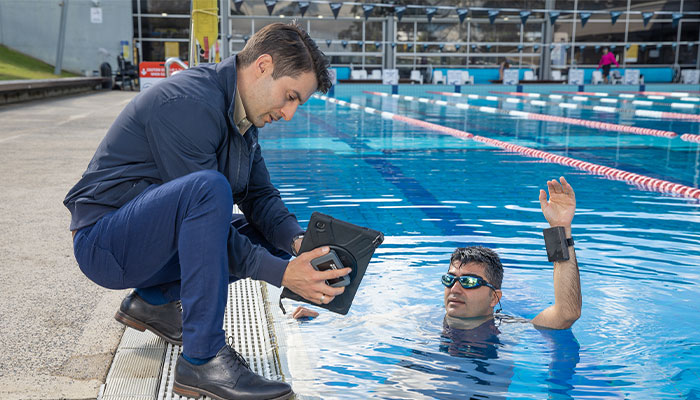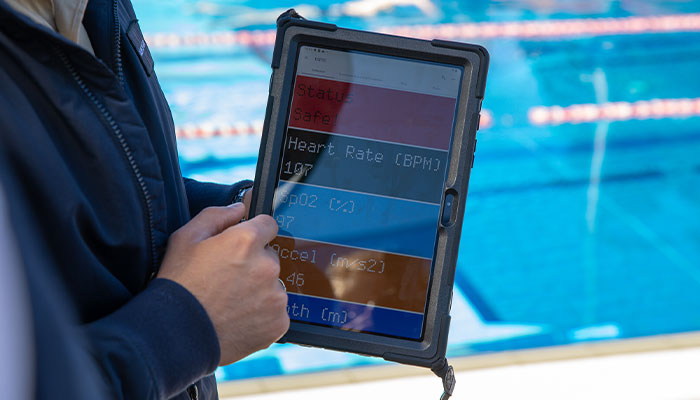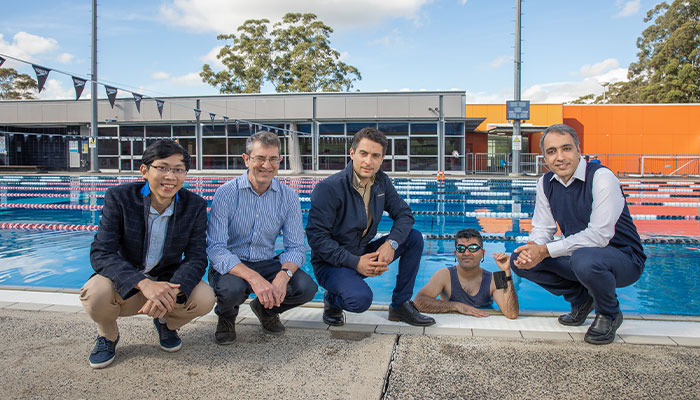Researchers at Macquarie University are trialling a prototype device that detects a swimmer's heart rate, oxygen and movement patterns, using floating transmitters to send potentially lifesaving information to rescuers.
“A surprisingly high number of people who drown are good swimmers,” says Dr Mohsen Asadnia, Associate Professor at Macquarie University’s School of Engineering.
“Drowning can happen quickly and quietly and people swimming in deep water aren’t easy to keep track of – that’s why a wearable device is ideal,” he says.
The device uses sensors to detect heart rate, blood oxygen, water depth, submersion time and movement patterns, overcoming substantial challenges like underwater wireless communication to create a system with the potential to save thousands of lives worldwide each year.
When a person is missing in the water, the time taken to locate them is critical to their survival.
The waterproof device – currently named APPTRAKK – can be tailored to suit both the user and the conditions, monitoring people in a range of hazardous aquatic environments including back yard swimming pools for children using artificial intelligence to identify distress in swimmers.

Water safety: Mohsen Asadnia and Salman Jalalifar test the device, which uses sensors to detect heart rate, water depth and more. Picture: Maja Baska
Over this past winter, the team has continued improving the device, making it smaller and adding features such as the ability to customise alerts to suit different swimmer capabilities.
They hope to trial an early prototype with Manly Surf Life Saving Club lifeguards later this summer.
Drowning deaths are on the rise in Australia, according to the Royal Life Saving National Drowning Report 2021, which found a 20 per cent increase in drowning deaths between July 2020 and June 2021 compared to the previous 12 months.
During 2020-21, 294 people drowned in Australian waterways and 674 people were recorded as experiencing a ‘non-fatal drowning incident resulting in life-long medical care.’
Silent and deadly
Asadnia says that a substantial body of research shows that drowning tends to be silent, as people use most of their energy trying to keep their heads above water, and if they panic as water gets into their airways, may be unable to call or signal for help.

Life saver: Dr Asadnia takes a read out ... the Macquarie invention can monitor people in a range of hazardous aquatic environments. Picture: Maja Baska
“A drowning person is usually only spotted if someone sees them struggling in the water with difficulty breathing,” he says.
Victims can remain upright while this happens – and can sink below the surface after just 20 to 60 seconds unless a trained lifeguard can reach them.
“When a person is missing in the water, the time taken to locate them is critical to their survival,” he says.
Drowning prevention strategies include swimmer education, regulations and close monitoring, but while all of these have reduced deaths, hundreds of Australians still drown each year.
“Developing an accurate device to detect dangerous situations where a swimmer is in trouble in the water or on the verge of drowning, could dramatically reduce water-related deaths and accidents, save lives and reduce the amount of money spent on search and rescue,” says Asadnia.
Smile like Drake funding
The research has been partly funded by the Smile Like Drake Foundation, which was established by the Drake family to develop and promote water safety solutions, in memory of 23-year old law student and former professional surfer Christopher Drake.

Making a splash: Research team members (from left) Hoang Phuc Phan, Andrew Belford, Mohsen Asadnia, Salman Jalalifar and Rouzbeh Abbassi. Picture: Maja Baska
In March 2013, the family went through terrible tragedy when Chris drowned, thrown from the North Curl Curl rock pool into rough seas by a freak wave while helping others to safety, with rescue teams unable to recover his body for five agonising days.
“We believe that Chris’s drowning was preventable, so we utilised our deep grief to commence our own analysis of fatal and non-fatal drownings in ocean pools, dams, rivers, waterways and backyard swimming pools,” says Nicolle Drake, Chris’s mother.
- Single sex v co-ed: which is better for kids' education?
- The Great Resignation: Purpose and meaning matter more than ever
She says that time is critical when trying to locate a missing person and the device could fast-track rescue and resuscitation.
“If Chris was wearing APPTRAKK at the time he went missing, it may not have changed the outcome however, we would have been able to say goodbye and donate his precious organs,” Mrs Drake says.
Macquarie University engineering professor Michael Heimlich began researching the device in 2017, and Associate Professor Asadnia has continued to lead the work following Professor Heimlich's death earlier this year.
Donations of $2 or more to the Smile Like Drake Foundation are tax deductible and will help fund research to reduce drowning fatalities.
Dr Mohsen Asadnia is Associate Professor in the School of Engineering at Macquarie University.



